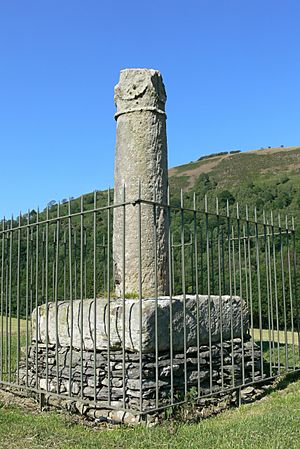Pillar of Eliseg facts for kids
The Pillar of Eliseg is an ancient stone pillar found in Denbighshire, Wales. It is also known as Elise's Pillar or Croes Elisedd in Welsh. This important monument stands close to Valle Crucis Abbey. King Cyngen ap Cadell (who died in 855 AD) had it built. He was the king of a place called Powys. He made the pillar to honor his great-grandfather, Elisedd ap Gwylog. The name "Eliseg" carved on the pillar is thought to be a small mistake made by the person who carved it.
Contents
History of the Pillar
The Pillar of Eliseg itself was put up in the 800s. This was a time when kings ruled different parts of Wales. However, the large hill or mound where the pillar stands is much older. Experts believe this mound was built a very long time ago. It might even be from the Bronze Age, which was around 2000 BC.
The Ancient Inscription
The Pillar of Eliseg has a special message carved into it. This message is called an inscription. It was written in Latin, an old language. The inscription had about 31 lines of writing. It told stories about important people mentioned in another old book called the Historia Britonum. It also added new information to those stories.
In 1696, a person named Edward Lluyd carefully copied the inscription. His copy was very accurate. This was important because the original writing on the pillar is now hard to read.
What the Inscription Says
The inscription on the pillar is one of the longest old writings found in Wales. It tells us several things:
- It names the family line: Concenn, son of Cattell, son of Brochmail, son of Eliseg, son of Guoillauc.
- It says that Concenn, who was Eliseg's great-grandson, built this stone for Eliseg.
- It praises Eliseg. It says he brought the land of Powys back together. He fought against the Angles (an old name for English people) using his sword and fire.
- It asks anyone who reads the stone to bless Eliseg's soul.
- It mentions that Concenn took back a lot of land (about 4.5 square kilometers) for his kingdom of Powys.
- It talks about other important figures like Magnus Maximus, a Roman leader. It also mentions Britu, son of Vortigern, and Sevira.
- Finally, it says that a person named Conmarch carved this writing. He did it because King Concenn asked him to.
- The inscription ends with a blessing. It asks for the Lord's blessing on Concenn and his family. It also asks for a blessing on the whole region of Powys forever.
During the English Civil War, the pillar was knocked down by soldiers called Roundheads. They even dug up a grave under it. In 1779, the top half of the pillar was put back up. Sadly, the original carving is now very difficult to see.
Digging Up the Past
People have studied the mound under the pillar for a long time. In 1773, the landowner, Trevor Lloyd, looked inside. He said he found a stone box, called a cist burial, with a skeleton and other items. He took these items away.
More recently, from 2010 to 2012, a group called Project Eliseg dug up the mound. They found that the mound was built in different stages.
- The first part was a platform made of stones. This was built around 2000 BC. Inside, they found a small stone box. It had burnt human bones, showing it was a burial site.
- The second stage was when the mound was made taller. This part also had a large stone box. It is thought to be from the Early Bronze Age. No human remains were found in this specific box.
- Another stone box was found in this stage. It held about 7 kilograms of burnt bones. These bones belonged to many people, including adults, teenagers, and babies. A flint knife and a bone pin were also found.
- The last part of the mound was built more recently. This was probably when the pillar was put back up in 1779.
See also
 In Spanish: Pilar de Eliseg para niños
In Spanish: Pilar de Eliseg para niños



